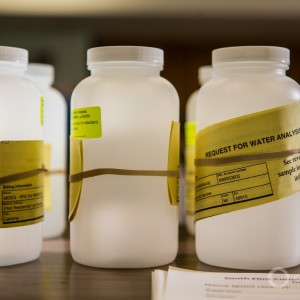Federal Water Tap, January 25: Biden Administration Begins with Executive Orders
The Rundown
President Biden took office and froze his predecessor’s rules that had not yet gone into effect. The GAO identifies funding challenges for an Army Corps navigation and ecosystem program in the upper Mississippi River basin. The Interior Department submits a report to Congress on water supply challenges in the western United States and efforts to respond to them. The Energy Department releases a report on hydropower growth in the United States. And lastly, USAID publishes its research agenda for more-effective water, sanitation, and hygiene policy.
“And if we go line by line in the American Rescue Plan, these provisions are — have been designed based on an assessment of need, and we think they’re going to absolutely be necessary. So, you know, I think that, looking forward, we’re quite confident that this is — this is the prudent assessment of needs.” — National Economic Council Director Brian Deese discussing President Biden’s proposed $1.9 trillion coronavirus response package. The proposal includes $5 billion to cover overdue household water and energy bills.
By the Numbers
$7.9 billion: Funding identified in 2004 by the Army Corps for 24 navigation and 1,010 ecosystem projects in the upper Mississippi River basin. But through 2020 the Corps had initiated work on only 41 projects, totaling $65 million. Other projects took priority, the Corps said. Cost-sharing requirements also proved a challenge. (GAO)
News Briefs
Biden Administration Begins with Executive Orders
On his first days in office, President Joe Biden gave his pen a workout.
Biden signed a sheaf of executive orders, hitting the brakes on rules that his predecessor sought to complete at the last minute.
One order is a “regulatory freeze” that pulls back rules that have not yet gone into effect so that the new administration can review them.
According to Alan Roberson, executive director of the Association of State Drinking Water Administrators, three recent EPA drinking water rules fall under the regulatory freeze: revisions to the Lead and Copper Rule, a determination to regulate PFOA and PFOS in drinking water, and a list of unregulated contaminants that will be subjected to testing. “What that really means as far as effective dates, timing, and potential revisions are all up in the air,” Roberson wrote.
The EPA press office did not respond to questions before deadline about how the freeze would affect the regulatory determinations for PFOA and PFOS.
Biden signed another order that requires agencies to review regulations, guidelines, and actions finalized in the last four years that conflict with his priorities on health, environment, and climate change. The order directs agencies to suspend, revise, or revoke the actions and to “immediately commence work to confront the climate crisis.”
The order also revokes two water-related memos from the previous administration, both on water supply in the west.
The order establishes an interagency working group to determine the social cost of greenhouse gases, a number that estimates the damage from heat-trapping gases. The Trump administration decreased the number used in carbon accounting, a government audit found.
Administration Announces Water Leadership
Now that the cabinet secretaries have been nominated, the administration is filling out the rest of the agency staff. Two appointments last week are directly involved in water.
Radhika Fox was nominated as principal deputy assistant administrator for the EPA Office of Water. Fox was the chief executive officer of the U.S. Water Alliance, a nonprofit group that championed water infrastructure.
Tanya Trujillo was nominated as principal deputy assistant secretary for water and science for the Department of the Interior, an office that oversees the Bureau of Reclamation and U.S. Geological Survey. Trujillo was most recently with the New Mexico Interstate Stream Commission.
Studies and Reports
Water in the West Report
The Department of the Interior submitted a report to Congress on water supply challenges in the western United States and efforts to respond to them. The report is required every five years.
As the concentration of heat-trapping greenhouse gases in the atmosphere rises, the eight major western watersheds are expected to see warmer temperatures, declining snowpack, and stream flows that peak earlier in the year. Droughts are expected to become longer and more severe.
Hydropower Report
The use of twinned reservoirs to store energy is growing as fast as all other energy-storage technologies in the United States, according to a Department of Energy report on the hydropower market.
The number of pumped-storage hydropower projects in the permitting, licensing, or construction stages increased by 31 percent in 2019. Top states with projects under development include Pennsylvania, Arizona, and California.
At the same time, U.S. hydropower capacity is growing marginally due to the addition of turbines at existing dams and canals. Installed capacity grew 431 megawatts from 2017 to 2019.
In context: U.S. Hydropower Grows By Going Small
On the Radar
USAID Research Agenda
The U.S. Agency for International Development outlined its top research priorities for more effectively improving access to water, sanitation, and hygiene globally.
The research questions related to governance, financing, regulation, and watershed management.
The research will be developed in partnership with universities, nonprofits, other government agencies, and the private sector.
Confirmation Hearings
On January 27, the Senate Committee on Energy and Natural Resources will hold a hearing for Jennifer Granholm, the nominee to lead the Department of Energy.
The committee has not yet scheduled a hearing for Rep. Deb Haaland, the nominee for the Interior Department.
The Senate Environment and Public Works Committee has not yet scheduled a hearing for Michael Regan, the EPA nominee. Same for the Senate Agriculture Committee, which will be hearing from Tom Vilsack, the U.S. Department of Agriculture nominee.
Federal Water Tap is a weekly digest spotting trends in U.S. government water policy. To get more water news, follow Circle of Blue on Twitter and sign up for our newsletter.
Brett writes about agriculture, energy, infrastructure, and the politics and economics of water in the United States. He also writes the Federal Water Tap, Circle of Blue’s weekly digest of U.S. government water news. He is the winner of two Society of Environmental Journalists reporting awards, one of the top honors in American environmental journalism: first place for explanatory reporting for a series on septic system pollution in the United States(2016) and third place for beat reporting in a small market (2014). He received the Sierra Club’s Distinguished Service Award in 2018. Brett lives in Seattle, where he hikes the mountains and bakes pies. Contact Brett Walton





Leave a Reply
Want to join the discussion?Feel free to contribute!